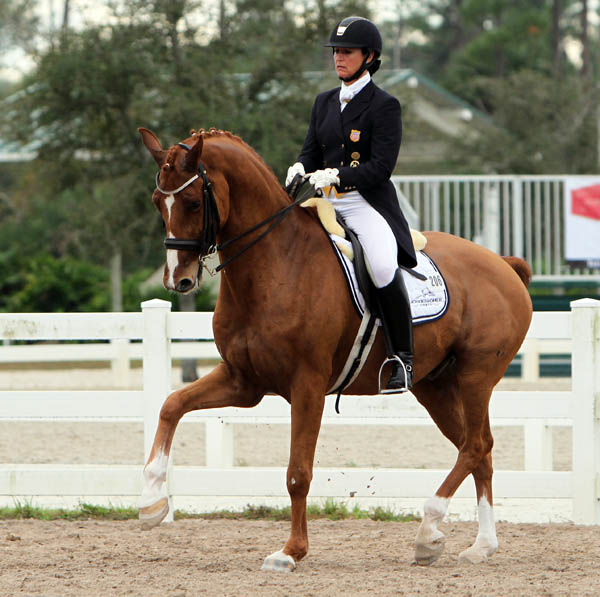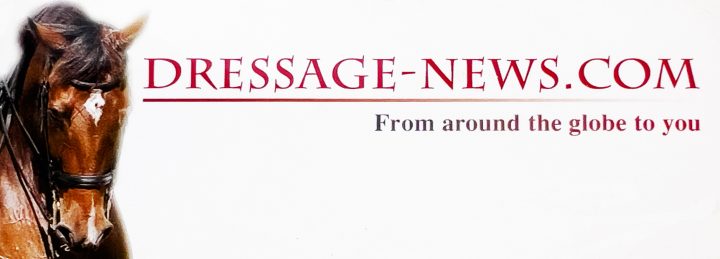Catherine Haddad Staller On American Dressage – Part 2 of 2
12 years ago StraightArrow Comments Off on Catherine Haddad Staller On American Dressage – Part 2 of 2

By KENNETH J. BRADDICK
A surprise for Catherine Haddad Staller on returning home to America after 20 years in Europe was “the vast quantity of quality horses” around her in a fantastic horse industry in Florida but a level of riding and training that needs improvement.
“A lot of good horses not being ridden well enough,” was her candid opinion, an outspokenness from the 48-year-old that many in America’s dressage world welcome and appreciate that within weeks of moving back she has been tapped for membership on the U.S. Equestrian Federation’s policy-creating High Performance Dressage Committee and may be on other federation bodies that have a big impact on the sport.
Catherine flew with her stable full of horses over Hallowe’en at the end of October–“some say I flew in on my broom”–directly to Florida rather than to Califon, New Jersey, where her husband of two years, Greg, has a successful veterinary practice.
She relishes the calendar of competitions–including 11 CDIs–virtually every week from December through April at four different show grounds no more than a half-hour apart which she says is “necessary to stay.”
But that is only a few months a year, and “I’m sure I’ll be returning to Europe to do some of the bigger shows there.”
Originally from Michigan, she went to Europe expecting to stay a week, and that stretched out to 20 years. She was reserve for the U.S. at the World Equestrian Games in both 2006 and 2010. And she competed in two World Cup Finals.
Organizers of some of the biggest shows in Europe have told this correspondent they liked her riding at their competitions because she is popular with the media, articulate and frequently humorous but always candid, and that helps promote the sport. And in recent years she has become an office holder of the freshly invigorated International Dressage Riders Club headed up by Olympian and team trainer and equally candid Kyra Kyrklund.
Now, she is back with Winyamaro, a 13-year-old Hanoverian gelding (Walt Disney x Taiga x Trapper) who is being prepared for a return to the Grand Prix arena after a year off recovering from a ligament injury; Hotmail 2, an 11-year-old Oldenburg gelding (Michellino x Redema x Havel) competing at Intermediate II; Patronus, a 10-year-old Danish Warmblood gelding (Heslegard’s Platin x Heslegard’s Laxmi x Heslegard’s Louis) and some younger horses.
With Winyamaro, the third horse she has developed for her to compete on the elite international circuit, Catherine went to the World Cup Final in Leipzig, Germany in 2011 but the ligament injury knocked the pair out of the contention for the selection trials for the U.S. team at the Olympics last year.

In reorganizing her life in the United States after 20 years in Germany, she is exploring the opportunities.
Among the most pleasant early experiences since basing herself for the winter in Loxahatchee, a community in the orbit of Florida’s Winter Equestrian Festival. is the White Fences Equestrian Center, just a few minutes hack from her barn. The show grounds were the center of dressage in Florida for many years. The competition and warmup arenas have been rebuilt that Catherine said equals those of top shows and new stabling has been added while creating an atmosphere that makes her feel at home–including free pizza at lunch.
On a broader scale, though, she quickly commited herself to working with her peers as she was elected by eligible athletes, riders who have competed on U.S. teams, to a committee that in turn led to dealing with high performance.
“I feel I have lot to offer,” she said. “It’s very important to me that the level of sport in this country gets improved.
“I would like to see the USA become a dressage power. I’d like to be a part of that not only as a competitor but in any way I can help. Many people have characterized me as being non-political. I’m someone who speaks my mind, I’m very direct. One of my political assets is people know they will always get a straight answer from me.”
“I have a lot of ideas I’d like to discuss,” Catherine said.
Those ideas include the direction for the future of American dressage.
“For the sport in the country we have to invest a lot more money in good schooling and training for our riders,” she said. “I haven’t seen a lot of riders who have absorbed a good system they can be successful with.”
Dressage “needs a new leader; we need somebody fast. I don’t think we should be taking our time. I think we need to get organized for the direction of the sport, not just to help the top of sport but all levels. We need to do it quickly. Normandy is just around the corner.”
The new leader of American dressage should be a very good organizer, a spokesperson for the sport, well trained enough to be a good observer to be able to help personal trainers of top riders.
“What’s really essential,” Catherine said, “is getting more funding for riders in the sport for all levels. The new coach has to demand certain things in return for funding–Grest Britain is a brilliant example–to be a strong advocate of good management” of high performance combinations.

